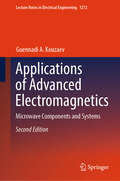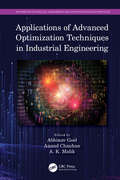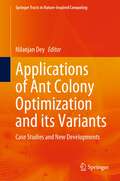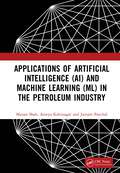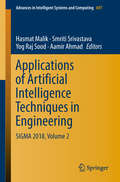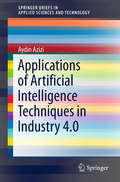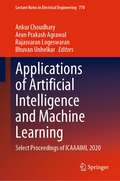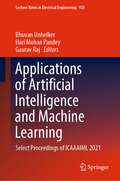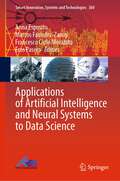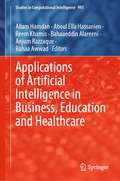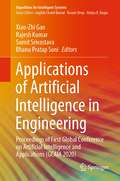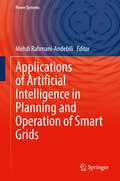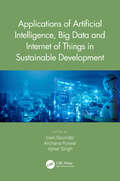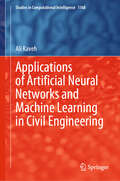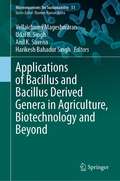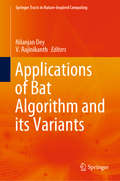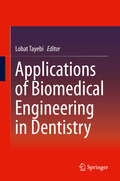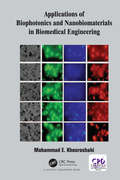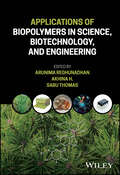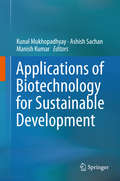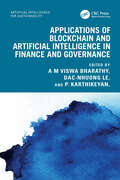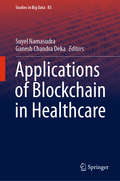- Table View
- List View
Applications of Advanced Electromagnetics: Microwave Components and Systems (Lecture Notes in Electrical Engineering #1272)
by Guennadi A. KouzaevThis book addresses microwave researchers, engineers, and Master's and Ph.D. students. It follows the idea of the first Edition to educate the readers on fundamental electromagnetics and show how this brilliant theory is used in developing modern multi-physics microwave and terahertz hardware. The first three chapters discuss the main ideas and methods of electromagnetism, explained in a manner that is clear for readers who have had some initial knowledge of electromagnetism. Chapters 4 and 5 are on transmission lines. The first text is on the integrated ones for digital applications, which have been working since DC up to several tens or hundreds of gigahertz. The next chapter is on the waveguides for terahertz frequencies. In this book, the space-modulated signals application, compared to the 1st Edition, is considered using the example of a novel predicate variable logic processor designed and verified in an FPGA environment (Chapter 6). This idea, born initially in microwaves, allowed an eight-logic-style re-configurable on-the-fly processor. Chapters 7–9 discuss microwaves in heating liquids and the initiation of rapid chemical reactions in novel miniature quasi-TEM wave reactors. Chapter 10 involves results on trapping and transporting ultra-cold matter using combined techniques. The new results described here are on numerical simulation of trapping of ultra-cold atoms in random 3D optical potentials using the Anderson effect. In conclusion, the author hopes this book will strengthen the young generation's interest in microwave field theory. He believes that advanced electromagnetism, combined with other physics branches, will play a crucial role in developing new, improved components and systems, and this book is a stepping-stone example in that journey.
Applications of Advanced Optimization Techniques in Industrial Engineering (Information Technology, Management and Operations Research Practices)
by Abhinav Goel Anand Chauhan A. K. MalikThis book provides different approaches used to analyze, draw attention, and provide an understanding of the advancements in the optimization field across the globe. It brings all of the latest methodologies, tools, and techniques related to optimization and industrial engineering into a single volume to build insights towards the latest advancements in various domains. Applications of Advanced Optimization Techniques in Industrial Engineering includes the basic concept of optimization, techniques, and applications related to industrial engineering. Concepts are introduced in a sequential way along with explanations, illustrations, and solved examples. The book goes on to explore applications of operations research and covers empirical properties of a variety of engineering disciplines. It presents network scheduling, production planning, industrial and manufacturing system issues, and their implications in the real world. The book caters to academicians, researchers, professionals in inventory analytics, business analytics, investment managers, finance firms, storage-related managers, and engineers working in engineering industries and data management fields.
Applications of Advanced Oxidation Processes (The Handbook of Environmental Chemistry #67)
by Antonio Gil Luis Alejandro Galeano Miguel Ángel VicenteThis volume reviews the drinking water treatments in which AOPs display a high application potential. Firstly it reveals the typical supply sources and limitations of conventional technologies and critically reviews natural organic matter characterization and removal techniques, focusing mainly on AOP treatments. It then explores using AOPs for simultaneous inactivation/disinfection of several types of microorganisms, including highly resistant Cryptosporidium protozoa. Lastly, it discusses relevant miscellaneous topics, like the most promising AOP solid catalysts, the regime change of Fenton-like processes toward continuous reactors, the application of chemometrics for process optimization, the impact on disinfection byproducts and the tracing of toxicity during AOP treatments. This work is a useful reference for researchers and students involved in water technologies, including analytical and environmental chemistry, chemical and environmental engineering, toxicology, biotechnology, and related fields. It is intended to encourage industrial and public-health scientists and decision-makers to accelerate the application of AOPs as technological alternatives for the improvement of drinking water treatment plants.
Applications of Ant Colony Optimization and its Variants: Case Studies and New Developments (Springer Tracts in Nature-Inspired Computing)
by Nilanjan DeyThis book explains the basic ideas behind several variants of ant colony optimization (ACO) and shows how they may be used in real-world settings like manufacturing, engineering design, and health care. Marco Dorigo proposed ACO for the first time, and it has been used to solve a variety of optimization problems. This book presents the latest developments of ACO.
Applications of Artificial Intelligence (AI) and Machine Learning (ML) in the Petroleum Industry
by Manan Shah Ameya Kshirsagar Jainam PanchalToday, raw data on any industry is widely available. With the help of artificial intelligence (AI) and machine learning (ML), this data can be used to gain meaningful insights. In addition, as data is the new raw material for today’s world, AI and ML will be applied in every industrial sector. Industry 4.0 mainly focuses on the automation of things. From that perspective, the oil and gas industry is one of the largest industries in terms of economy and energy. Applications of Artificial Intelligence (AI) and Machine Learning (ML) in the Petroleum Industry analyzes the use of AI and ML in the oil and gas industry across all three sectors, namely upstream, midstream, and downstream. It covers every aspect of the petroleum industry as related to the application of AI and ML, ranging from exploration, data management, extraction, processing, real-time data analysis, monitoring, cloud-based connectivity system, and conditions analysis, to the final delivery of the product to the end customer, while taking into account the incorporation of the safety measures for a better operation and the efficient and effective execution of operations. This book explores the variety of applications that can be integrated to support the existing petroleum and adjacent sectors to solve industry problems. It will serve as a useful guide for professionals working in the petroleum industry, industrial engineers, AI and ML experts and researchers, as well as students.
Applications of Artificial Intelligence Techniques in Engineering: SIGMA 2018, Volume 2 (Advances in Intelligent Systems and Computing #697)
by Aamir Ahmad Hasmat Malik Smriti Srivastava Yog Raj SoodThe book is a collection of high-quality, peer-reviewed innovative research papers from the International Conference on Signals, Machines and Automation (SIGMA 2018) held at Netaji Subhas Institute of Technology (NSIT), Delhi, India. The conference offered researchers from academic and industry the opportunity to present their original work and exchange ideas, information, techniques and applications in the field of computational intelligence, artificial intelligence and machine intelligence. The book is divided into two volumes discussing a wide variety of industrial, engineering and scientific applications of the emerging techniques.
Applications of Artificial Intelligence Techniques in Industry 4.0 (SpringerBriefs in Applied Sciences and Technology)
by Aydin AziziThis book is to presents and evaluates a way of modelling and optimizing nonlinear RFID Network Planning (RNP) problems using artificial intelligence techniques. It uses Artificial Neural Network models (ANN) to bind together the computational artificial intelligence algorithm with knowledge representation an efficient artificial intelligence paradigm to model and optimize RFID networks.This effort leads to proposing a novel artificial intelligence algorithm which has been named hybrid artificial intelligence optimization technique to perform optimization of RNP as a hard learning problem. This hybrid optimization technique consists of two different optimization phases. First phase is optimizing RNP by Redundant Antenna Elimination (RAE) algorithm and the second phase which completes RNP optimization process is Ring Probabilistic Logic Neural Networks (RPLNN). The hybrid paradigm is explored using a flexible manufacturing system (FMS) and the results are compared with well-known evolutionary optimization technique namely Genetic Algorithm (GA) to demonstrate the feasibility of the proposed architecture successfully.
Applications of Artificial Intelligence and Machine Learning: Select Proceedings of ICAAAIML 2020 (Lecture Notes in Electrical Engineering #778)
by Bhuvan Unhelkar Ankur Choudhary Arun Prakash Agrawal Rajasvaran LogeswaranThe book presents a collection of peer-reviewed articles from the International Conference on Advances and Applications of Artificial Intelligence and Machine Learning - ICAAAIML 2020. The book covers research in artificial intelligence, machine learning, and deep learning applications in healthcare, agriculture, business, and security. This volume contains research papers from academicians, researchers as well as students. There are also papers on core concepts of computer networks, intelligent system design and deployment, real-time systems, wireless sensor networks, sensors and sensor nodes, software engineering, and image processing. This book will be a valuable resource for students, academics, and practitioners in the industry working on AI applications.
Applications of Artificial Intelligence and Machine Learning: Select Proceedings of ICAAAIML 2021 (Lecture Notes in Electrical Engineering #925)
by Hari Mohan Pandey Bhuvan Unhelker Gaurav RajThe book presents a collection of peer-reviewed articles from the International Conference on Advances and Applications of Artificial Intelligence and Machine Learning—ICAAAIML 2021. The book covers research in the areas of artificial intelligence, machine learning, and deep learning applications in health care, agriculture, business, and security. This book contains research papers from academicians, researchers as well as students. There are also papers on core concepts of computer networks, intelligent system design and deployment, real-time systems, wireless sensor networks, sensors and sensor nodes, software engineering, and image processing. This book is a valuable resource for students, academics, and practitioners in the industry working on AI applications.
Applications of Artificial Intelligence and Neural Systems to Data Science (Smart Innovation, Systems and Technologies #360)
by Anna Esposito Marcos Faundez-Zanuy Francesco Carlo Morabito Eros PaseroThis book provides an overview on the current progresses in artificial intelligence and neural nets in data science. The book is reporting on intelligent algorithms and applications modeling, prediction, and recognition tasks and many other application areas supporting complex multimodal systems to enhance and improve human–machine or human–human interactions. This field is broadly addressed by the scientific communities and has a strong commercial impact since investigates on the theoretical frameworks supporting the implementation of sophisticated computational intelligence tools. Such tools will support multidisciplinary aspects of data mining and data processing characterizing appropriate system reactions to human-machine interactional exchanges in interactive scenarios. The emotional issue has recently gained increasing attention for such complex systems due to its relevance in helping in the most common human tasks (like cognitive processes, perception, learning, communication, and even "rational" decision-making) and therefore improving the quality of life of the end users.
Applications of Artificial Intelligence in Business, Education and Healthcare (Studies in Computational Intelligence #954)
by Aboul Ella Hassanien Allam Hamdan Anjum Razzaque Bahaaeddin Alareeni Reem Khamis Bahaa AwwadThis book focuses on the implementation of Artificial Intelligence in Business, Education and Healthcare, It includes research articles and expository papers on the applications of Artificial Intelligence on Decision Making, Entrepreneurship, Social Media, Healthcare, Education, Public Sector, FinTech, and RegTech. It also discusses the role of Artificial Intelligence in the current COVID-19 pandemic, in the health sector, education, and others. It also discusses the impact of Artificial Intelligence on decision-making in vital sectors of the economy.
Applications of Artificial Intelligence in Engineering: Proceedings of First Global Conference on Artificial Intelligence and Applications (GCAIA 2020) (Algorithms for Intelligent Systems)
by Xiao-Zhi Gao Rajesh Kumar Sumit Srivastava Bhanu Pratap SoniThis book presents best selected papers presented at the First Global Conference on Artificial Intelligence and Applications (GCAIA 2020), organized by the University of Engineering & Management, Jaipur, India, during 8–10 September 2020. The proceeding will be targeting the current research works in the domain of intelligent systems and artificial intelligence.
Applications of Artificial Intelligence in Planning and Operation of Smart Grids (Power Systems)
by Mehdi Rahmani-AndebiliArtificial intelligence (AI) is going to play a significant role in smart grid planning and operation, especially in solving its real-time problems, as it is fast, adaptive, robust, and less dependent on the system’s accurate model and parameters. This collection covers research advancements in the application of AI in the planning and operation of smart grids. A global group of researchers and scholars present innovative approaches to AI-based smart grid planning and operation, cover the theoretical concepts and experimental results of the application of AI-based techniques, and apply these techniques to deal with smart grid issues. Applications of Artificial Intelligence in Planning and Operation of Smart Grids is an ideal resource for researchers on the theory and application of AI, practicing engineers working in electrical power engineering, and students in advanced graduate-level courses.
Applications of Artificial Intelligence, Big Data and Internet of Things in Sustainable Development
by Sam Goundar Archana Purwar Ajmer SinghThis book focuses on different algorithms and models related to AI, big data and IoT used for various domains. It enables the reader to have a broader and deeper understanding of several perspectives regarding the dynamics, challenges, and opportunities for sustainable development using artificial intelligence, big data and IoT. Applications of Artificial Intelligence, Big Data and Internet of Things (IoT) in Sustainable Development focuses on IT-based advancements in multidisciplinary fields such as healthcare, finance, bioinformatics, industrial automation, and environmental science. The authors discuss the key issues of security, management, and the realization of possible solutions to hurdles in sustainable development. The reader will master basic concepts and deep insights of various algorithms and models for various applications such as healthcare, finance, education, smart cities, smart cars, among others. Finally, the book will also examine the applications and implementation of big data IoT, AI strategies to facilitate the sustainable development goals set by the United Nations by 2030. This book is intended to help researchers, academics, and policymakers to analyze the challenges and future aspects for maintaining sustainable development through IoT, big data, and AI.
Applications of Artificial Neural Networks and Machine Learning in Civil Engineering (Studies in Computational Intelligence #1168)
by Ali KavehThis book provides different applications of artificial neural networks (ANN) and machine learning (ML) in various problems of material science, structural optimization, and optimal analysis of structures in twenty two chapters. Nowadays, the world has witnessed unprecedented advances in technology and computer science. Artificial intelligence has emerged as a top field captivating global attention. Often referred to as AI, this technology stands apart from other disciplines as it aims to design machines and systems that exhibit intelligence, learn autonomously, and make decisions akin to humans. In order to comprehend the impact of this innovation, one must delve into the workings of artificial intelligence, trace its historical evolution from inception to the present day, and explore its diverse applications in domains like medicine, transportation, broadcasting, and marketing. Artificial intelligence introduces a transformative element to our reality, fostering significant breakthroughs and innovations. The book is used in any AI course, in particular, in Civil Engineering. It is also utilized in various fields of Industrial Civil Engineering.
Applications of Bacillus and Bacillus Derived Genera in Agriculture, Biotechnology and Beyond (Microorganisms for Sustainability #51)
by Harikesh Bahadur Singh Udai B. Singh Anil K. Saxena Vellaichamy MageshwaranThis edited volume provides a comprehensive view of the recent developments on Bacillus and their application in agriculture and allied sectors in a global scenario. Research articles sharing a consolidated state-of-the-art development in this area are solicited for this book. This book is a complete package covering all spheres of diversity and taxonomy, nutrient supplementation, biotic and abiotic stress management, biofilm and endophytic colonization, commercialization and regulatory mechanisms, etc. Descriptions of cutting-edge techniques and novel approaches on Bacillus research is also covered. A part of the book concentrates on the biotic and abiotic stress management in several important crops. It contains 11 contributory chapters from eminent experts in the field of life sciences specially microbiology, plant pathology and biotechnology working on different aspects of Bacilli and their application in agriculture and allied sectors. This book is useful for Graduate, Post-graduate students, research scholars, and post doctorate scholars of plant science, plant microbiology, soil microbiology and plant pathology discipline researchers, academicians, industrialists, policy makers.
Applications of Bat Algorithm and its Variants (Springer Tracts in Nature-Inspired Computing)
by Nilanjan Dey V. RajinikanthThis book highlights essential concepts in connection with the traditional bat algorithm and its recent variants, as well as its application to find optimal solutions for a variety of real-world engineering and medical problems. Today, swarm intelligence-based meta-heuristic algorithms are extensively being used to address a wide range of real-world optimization problems due to their adaptability and robustness. Developed in 2009, the bat algorithm (BA) is one of the most successful swarm intelligence procedures, and has been used to tackle optimization tasks for more than a decade. The BA’s mathematical model is quite straightforward and easy to understand and enhance, compared to other swarm approaches. Hence, it has attracted the attention of researchers who are working to find optimal solutions in a diverse range of domains, such as N-dimensional numerical optimization, constrained/unconstrained optimization and linear/nonlinear optimization problems. Along with the traditional BA, its enhanced versions are now also being used to solve optimization problems in science, engineering and medical applications around the globe.
Applications of Biomedical Engineering in Dentistry
by Lobat TayebiThis book offers readers a valuable overview of recent advances in biomedical engineering, as applied to the modern dentistry. It begins by studying the biomaterials in dentistry, and materials used intraoperatively during oral and maxillofacial surgery procedures. Next, it considers the subjects in which biomedical engineers can be influential, such as 3-dimensional (3D) imaging, laser and photobiomodulation, surface modification of dental implants, and bioreactors. Hard and soft tissue engineerings in dentistry are discussed, and some specific and essential methods such as 3D-printing are elaborated. Presenting particular clinical functions of regenerative dentistry and tissue engineering in treatment of oral and maxillofacial soft tissues is the subject of a separate chapter. Challenges in the rehabilitation handling of large and localized oral and maxillofacial defects is a severe issue in dentistry, which are considered to understand how bioengineers help with treatment methods in this regard. Recent advances in nanodentistry is discussed followed by a chapter on the applications of stem cell-encapsulated hydrogel in dentistry.Periodontal regeneration is a challenging issue in dentistry, and thus, is going to be considered separately to understand the efforts and achievements of tissue engineers in this matter. Oral mucosa grafting is a practical approach in engineering and treatment of tissues in ophthalmology, which is the subject of another chapter. Microfluidic approaches became more popular in biomedical engineering during the last decade; hence, one chapter focuses on the advanced topic of microfluidics technologies using oral factors as saliva-based studies. Injectable gels in endodontics is a new theme in dentistry that bioengineering skills can advance its development, specifically by producing clinically safe and effective gels with regeneration and antibacterial properties. Engineered products often need to be tested in vivo before being clinical in dentistry; thus, one chapter is dedicated to reviewing applicable animal models in dental research. The last chapter covers the progress on the whole tooth bioengineering as a valuable and ultimate goal of many dental researchers.Offers readers an interdisciplinary approach that relates biomedical engineering and restorative dentistryDiscusses recent technological achievements in engineering with applications in dentistryProvides useful tool to dental companies for future product planning, specifically to biomedical engineers engaged in dental research
Applications of Biophotonics and Nanobiomaterials in Biomedical Engineering
by Mohammad E. KhosroshahiThis book provides a link between different disciplines of nanophysics, biophotonics, nanobiomaterials & applications of nanobiophotonics in biomedical research and engineering. The fundamentals of light, matter, nanobiomaterials & nanophysics are discussed together, and relevant applications in biomedical engineering as well as other related factors influencing the interaction process are explicated. Theoretical and experimental research is combined, emphasizing the influence of crucial common factors on applications.
Applications of Biopolymers in Science, Biotechnology, and Engineering
by Sabu Thomas Arunima Reghunadhan Akhina H.APPLICATIONS OF BIOPOLYMERS IN SCIENCE, BIOTECHNOLOGY, AND ENGINEERING Single volume resource covering the many different applications of biopolymers, along with foundational knowledge like biodegradability and recent advancements Along with providing in-depth discussions on the fundamentals of biopolymers, such as synthesis, fabrication technologies, and properties, Applications of Biopolymers in Science, Biotechnology, and Engineering covers the applications of biopolymers in various fields such as biotechnology, construction and civil engineering, tissue engineering, dairy technology, packaging, electronics, food, medicine, tissue engineering, and biotechnology. Overall, the text conveys a broad overview of the field, enabling readers to grasp both the fundamentals and applications of the subject. Edited by three highly qualified academics with significant experience in the field, Applications of Biopolymers in Science, Biotechnology, and Engineering covers sample topics such as: Biopolymer blends, IPNs, gels, composites, and nanocomposites, and the properties, fabrication and applications of synthetic biopolymers Role of biopolymers and their composites in sustainable agriculture, covering recent developments and future perspectives Polymers suitable for the fabrication of prosthetics, and polymers’ uses in different stages of drug delivery and drug design Life cycle analysis, biodegradability, and advances in the overall field of biopolymers, along with polymers and biopolymers in sensing applications Covering both foundational knowledge and a myriad of applications, Applications of Biopolymers in Science, Biotechnology, and Engineering is an essential resource on the subject for practitioners, researchers, and scientists in polymer science and engineering, materials science, surface science, bioengineering, chemical engineering, and any industry/field interested in biopolymers and/or nanocomposites.
Applications of Biotechnology for Sustainable Development
by Manish Kumar Kunal Mukhopadhyay Ashish SachanThis book discusses different bioprocesses to produce value-added compounds, the science behind their production, the economics of their introduction to the marketplace, their environmental impacts, and their implications for world agriculture. It also provides insights into various technologies and protocols used. The major strength of biotechnology is its multidisciplinary nature and broad range of scientific approaches. Recent advances in various biotechnological fields are facilitating the production of fine chemicals, recombinant proteins, biomaterials and pharmaceuticals. Biotechnology plays an important role, especially in the fields of food production, renewable raw materials and energy, pollution prevention and bioremediation. Biotechnology's greatest contribution is in agriculture - in making crops more efficient. Resource recovery, recycling and hazardous-waste disposal are other environmentally beneficial facets of biotechnology. Thus, biotechnology is a pivotal tool for sustainable development, which has become a priority for the world's policy makers. The concept of sustainable development is based on the goal of increasing the basic standard of living of the world's growing population, without depleting finite natural resources and degrading the environment. Emerging biotechnologies offer novel approaches with the potential to achieve the goal of sustainability and striking a balance between developmental needs and environmental conservation.
Applications of Biotribology in Biomedical Systems
by Ashwani Kumar Abhishek Kumar Avinash KumarThis book summarizes the past, present, and future work in biotribology with a special emphasis on its applications in the design and manufacture of biomedical devices and their potential future uses. The book covers several aspects of biotribology such as biocompatible materials, joint tribology, skin tribology, oral tribology, tribology of the other human bodies or tissues, animal tribology, plant tribology, medical device tribology, and more. This is an essential reference for academics, biomedical researchers, biologists, tribologists, chemists, physicists, biomedical scientists, materials engineers, mechanical engineers and other professionals in related engineering, medicine, and biomedical industries. This book can also serve as a useful research text for undergraduate and graduate engineering courses such as tribology, materials, biomaterials, material characterization, interface science, and biomedical science.
Applications of Blockchain Technology in Business: Challenges and Opportunities (SpringerBriefs in Operations Management)
by Angappa Gunasekaran Mohsen AttaranThe book discusses the various ways that blockchain technology is changing the future of money, transactions, government, and business. The first two chapters walk through the foundation of blockchain. Chapters 3–12 look at applications of blockchain in different industries and highlight its exciting new business applications. It show why so many companies are implementing blockchain, and present examples of companies who have successfully employed the technology to improve efficiencies and reduce costs. Chapter 13 highlights blockchain’s powerful potential to foster emerging markets and economies including smart cities, value-based healthcare, decentralized sharing economy, machine to machine transactions, data-sharing marketplace, etc. Chapter 14 offers a conceptual model, provides information and insights, and covers a step-by-step approach to plan and develop blockchain-based technology.
Applications of Blockchain and Artificial Intelligence in Finance and Governance (Artificial Intelligence for Sustainability)
by Dac-Nhuong Le P. Karthikeyan A M Viswa BharathyIn the rapidly evolving landscape of finance and governance, the integration of blockchain technology and artificial intelligence is reshaping the way we perceive and interact with traditional systems. In Applications of Blockchain and Artificial Intelligence in Finance and Governance, the authors delve into the intricacies of this dynamic intersection, offering a comprehensive exploration of the transformative potential of these cutting-edge technologies. From dissecting the symbiotic relationship between artificial intelligence and blockchain to examining their profound impact on cryptocurrency markets, each chapter offers invaluable insights into the role of these technologies in shaping the future of finance. With a meticulous review of open risks and challenges, the book navigates through the complexities of data security in public and consortium blockchain systems, paving the way for enhanced trust and transparency in financial transactions. Through real-world case studies and theoretical frameworks, readers are guided through the application of intelligent resource allocation for data analytics, unlocking the potential for optimized decision-making in blockchain-enabled financial transactions. Moreover, the book explores the revolutionary implications of blockchain and AI in maintaining smart governance records, revolutionizing accountability and efficiency in public administration.This book: Introduces a step-by-step procedure for developing blockchain and artificial intelligence-based applications for the finance industry using decentralized applications and hyperledgers. Discusses improved trust framework and data integrity in the blockchain using artificial intelligence in the finance sector. Highlights the importance of blockchain in solving transaction costs, coordination costs, and supervision costs for efficient resource allocation. Explores the use of explainable artificial intelligence for policy development, service delivery, and regulatory compliance. Explains how federated learning can be used to build more accurate and robust models for financial risk assessment, fraud detection, and customer profiling. From the transformative effects on the accounting profession to the burgeoning adoption of blockchain technology in supply chain finance, this book serves as an indispensable guide for professionals, academics, and enthusiasts alike. Applications of Blockchain and Artificial Intelligence in Finance and Governance illuminates the path toward a more secure, efficient, and equitable financial future, where innovation and collaboration reign supreme.
Applications of Blockchain in Healthcare (Studies in Big Data #83)
by Ganesh Chandra Deka Suyel NamasudraThis book discusses applications of blockchain in healthcare sector. The security of confidential and sensitive data is of utmost importance in healthcare industry. The introduction of blockchain methods in an effective manner will bring secure transactions in a peer-to-peer network. The book also covers gaps of the current available books/literature available for use cases of Distributed Ledger Technology (DLT) in healthcare. The information and applications discussed in the book are immensely helpful for researchers, database professionals, and practitioners. The book also discusses protocols, standards, and government regulations which are very useful for policymakers.
